Small washbasins: varieties, photo-selection of options and features of choice
The basic requirements for plumbing for a small restroom are compactness, ergonomics, suitable stylistics. These parameters are characterized by a small sink in the toilet. It is a mini-copy of a standard device and does not lose to him in the number of design decisions.
You want the sink to be not only pretty, but also easy to use, right? Can't decide on a model? This is not surprising - the existing range is amazing, but at the same time makes it difficult to choose.
We will try to bring some clarity to this issue - in the article we will figure out how to choose such a washstand. We will help you to get a good understanding of models and stylistic nuances. Also, the material of the article is supplemented with colorful photo collections and video recommendations for the selection and installation of compact plumbing.
The content of the article:
General information and features of mini-sinks
Compact products are most often used as washstands. But they can also serve as a full bowl for washing. If the bathroom is separate, it is convenient to equip an extra bed (albeit miniature) in the toilet for hygiene procedures.
Installing a mini sink has its advantages:
- space saving;
- simple installation;
- the ability to hide communications.
Such products also have disadvantages. Small sizes make washing not very convenient, a large amount of spray is formed around.
Common sizes and shapes
The shape and size of the washbasin are selected depending on the purpose of use of the device, the area of the room.
The form distinguishes between such options:
- rectangular;
- angular;
- round;
- oval;
- fancy.
The first two groups are the most common of these. Corner small washbasins for toilet are popular because of the maximum space savings.
But when installing washbasins of this type, you need to leave enough space around for their convenient use. Ordinary rectangular constructions require an approach from one side only.
The diameter of the wash basins rarely exceeds 0.5 m. In numbers, it looks like this: width - 30-55 cm, depth - 20-55 cm.
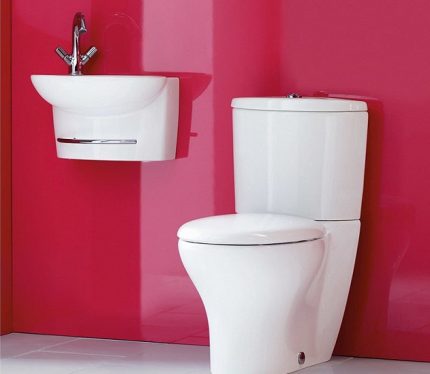
The dimensions of the sinks allow you to create basic amenities even in the smallest bathroom, but you must also take into account the features of the models.
The average width of the hinged structures is 23-25 cm, the depth parameters are 15-25 cm. These washbasins are produced in the most compact sizes to reduce the total weight.
The corners are attached to 2 walls, so they can be wider - 35-40 cm, and heavier. If under the sink there is a cabinet, tulip or other support, you can not think about weight.
Materials used in production
Most mini toilet sinks are made from sanitary ceramics. It is divided into two groups - sanitary ware and sanitary ware.
Sanitary ware is made from white clay and some impurities. The surface is porous, therefore, to protect it from moisture, dirt, detergents, it is covered with a thick layer of glaze.
Sanitary porcelain consists of the same white clay, but feldspar and quartz are added to it. Minerals give finished structures strength, durability, low porosity.
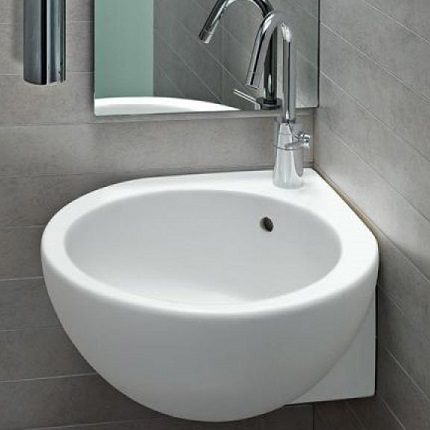
It is quite difficult to distinguish these two materials from each other “by eye”: they are made from the same raw material and are equally coated with glaze (it is simply thicker in sanitary ware). The composition of ceramics can be found in the passport of the washstand or from a store consultant.
Products from other materials already fall into the premium category due to the high cost. Natural stone sinks look expensive, but their porous surface needs additional impregnation. The durability of the product depends on the quality of the moisture-resistant composition.
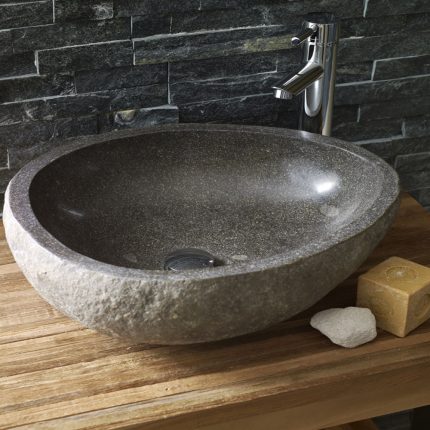
Artificial stone has several advantages over natural. It is equally durable and resistant to shocks, but withstands constant exposure to moisture without additional impregnation. And production by casting allows you to give the products the most unimaginable shapes and colors.
Another interesting material used in the production of mini-washstands is tempered glass. Light, transparent or colored items are quite rare, which makes them an exclusive item in interior design.
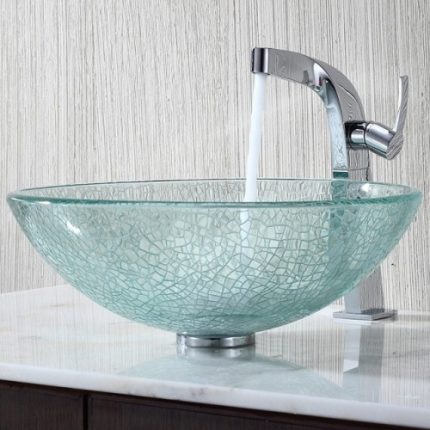
On sale there are also mini-shells made of acrylic. They are distinguished by low weight, durability, wide color gamut.
Especially for some interior styles (minimalism, hi-tech, Victorian, oriental), manufacturers produce metal washstands.
Products made of brass, bronze, patina, nickel, silver, even gold are characterized by high quality and unique appearance.
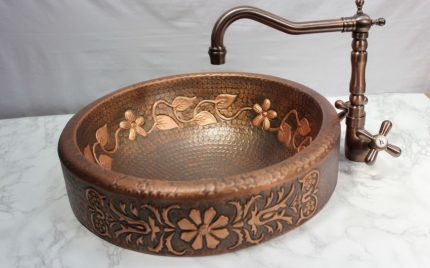
There are also relatively low-cost stainless steel models. But this strong and durable material is easily susceptible to mechanical stress; over time, scratches appear on the surface of the sink.
Of the materials unexpected for plumbing, wood is used.Oak and larch products become more durable from prolonged contact with water. And iroko and teak wood is considered waterproof.
The bowls of such washbasins are treated with oils, varnishes, impregnations, but this does not relieve them of sensitivity to damage.
Varieties of washbasins by installation method
If a major overhaul of the toilet room with the replacement of water pipes, wall decoration is planned, the configuration of the model is not critical. When only plumbing is supposed to be updated, this item becomes the main one, because the choice of a washbasin directly depends on the device of communication systems.
Most popular hanging models
Fastening such a washstand to the wall is done using special studs. It is important to pre-mark the place of their installation. The studs are located on the same horizontal, and the distance between them should clearly correspond to the segment between the holes on the sink.
When the marking is done, the wash basin is assembled (a siphon, faucet is connected), holes are drilled in the wall, fasteners are mounted on them, on which the bowl is put on, the structure is fixed with nuts.
Between the sink and the wall, a silicone pillow is required. It serves as an additional fastener and softening buffer.
If the sink is heavy, additional fasteners come with it. Let's look at possible design options for a washroom with miniature washbasins.
Hanging sinks take up little space, are easy to clean, and do not burden the interior. Some buyers are confused by the openness of the water pipes, but thanks to the stylish chrome-plated siphons and neat modern designs, this problem is easily solved.
Floor standing with tulip or pedestal
Tulip or pedestal sinks are installed similarly to hanging ones. The only difference is that their height is initially set by the lower structure and this makes the task a little easier.
If you have chosen a narrow moydodyr sink, it can be installed in the toilet without fittings or glued to the wall with silicone.
Washbasins on the leg are mounted close to the wall. They need to be protected from the load - a thin base may burst.
Please note that often during installation, floor structures require a drain into the sewer from below, but there are also instances with a release into the wall.
Recessed and overhead structures
In conditions of very limited space, it is better not to use such washstands - a countertop is mandatory for them. But here, mini-options are possible.
The installation principle of embedded products is similar to the installation of kitchen sinks. The washstand is glued to the base, which serves as a sealant and fastener.
Custom Design Overview
One of the options how to use the space in a miniature restroom as much as possible is to place a sink over the toilet.
The washstand above the drain tank will not occupy the useful area and will help in arranging a tiny room.
Waves, waterfalls, drops - most design ideas are associated with the water element. Asymmetric shells stand apart. They are convenient opportunity to approach from different angles.
What to consider before buying?
Pay attention to the presence of an overflow hole in the model. Most manufacturers include it in the default design.
Overflow ensures safety and ease of use of the sink.
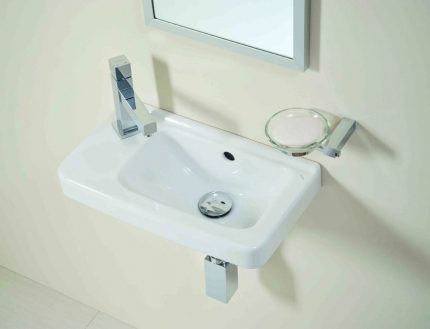
When purchasing a mini sink in the toilet, keep in mind that not only its cost and design features are important. The style and color of the washbasin should be in harmony with the overall design solution of the room.
Preliminary measurements before purchase. Imagine whether it will be convenient to use the selected model. The standard height of such structures is 75-95 cm. If there is a cupboard under the bowl, some correction for height is needed.
Some more recommendations:
- If the bathroom is rectangular, the angular model will be more convenient.
- When choosing a model with a cabinet, keep in mind that the cabinet material must withstand high humidity.
- The mixer is better to choose a short and low.
- If the kit includes a hygienic shower, all necessary accessories must be supplied to it.
The decision to purchase a washstand made of exotic material must be accompanied by an understanding of the complexity of care. Onyx, marble, granite will not last long if improperly used. If unpretentiousness and practicality are important, stop on ceramics.
Already during the purchase process, inspect the product for chips, cracks, unevenly painted areas, spots and other defects.
Conclusions and useful video on the topic
The option of arranging a toilet room with a mini-sink in the "stalin".
A mini-washstand and two glass shelves above it.
The idea of placing a washbasin in the wall.
The assortment of mini-washbasin sinks surprises even the most demanding buyers.Hundreds of colors, models, dimensional parameters make it possible to find your own stylistic solution.
Measure the room, consider the features of the interior, select the type of device for the existing conditions, consider installation. After such preparation it will be easier to determine at the time of purchase.

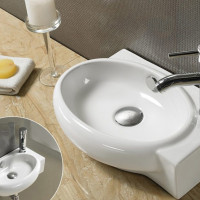 Small bathroom sinks: the nuances of choice and installation + photo selection of ideas
Small bathroom sinks: the nuances of choice and installation + photo selection of ideas 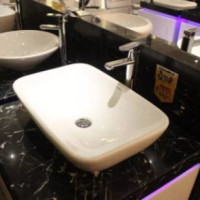 Countertop washbasin: features of selection and installation
Countertop washbasin: features of selection and installation 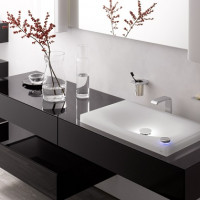 How to determine the dimensions of the sink for the bathroom and not screw up during the repair
How to determine the dimensions of the sink for the bathroom and not screw up during the repair 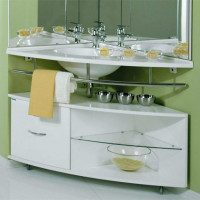 Corner sinks in the bathroom: general overview + installation instructions
Corner sinks in the bathroom: general overview + installation instructions 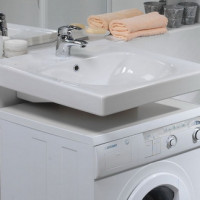 Sink above the washing machine: design features + mounting nuances
Sink above the washing machine: design features + mounting nuances 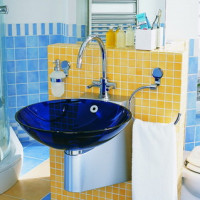 Glass bathroom sinks: types, pros and cons, an overview of the best manufacturers
Glass bathroom sinks: types, pros and cons, an overview of the best manufacturers  How much does it cost to connect gas to a private house: the price of organizing gas supply
How much does it cost to connect gas to a private house: the price of organizing gas supply  The best washing machines with dryer: model rating and customer tips
The best washing machines with dryer: model rating and customer tips  What is the color temperature of light and the nuances of choosing the temperature of the lamps to suit your needs
What is the color temperature of light and the nuances of choosing the temperature of the lamps to suit your needs  Replacement of a geyser in an apartment: replacement paperwork + basic norms and requirements
Replacement of a geyser in an apartment: replacement paperwork + basic norms and requirements
The very idea of such a sink is interesting and useful. And spray is not a problem, because in modern mixers there is a jet with a mixture of air through aerators and it does not spray at all.